SIM337: Southwest Airlines Analysis
VerifiedAdded on 2019/10/08
|41
|9143
|203
Report
AI Summary
This report provides a comprehensive analysis of Southwest Airlines, examining its external business environment and competitive position. Using PESTLE analysis, the report assesses macro-environmental factors impacting the airline, including political, economic, socio-cultural, technological, and ecological influences. Porter's Five Forces framework is employed to evaluate the competitive landscape, considering industry rivalry, barriers to entry, threat of substitutes, supplier power, and buyer power. The report further explores the effects of barriers to globalization on the airline industry and Southwest's strategies for navigating these challenges. It analyzes Southwest's resource and competencies, its strategic overview, and the effectiveness of its response to globalization barriers. The report also evaluates Southwest's competitive advantage through cost leadership, differentiation, and market focus strategies, suggesting areas for improvement, such as integrating AirTran's operations, expanding into international markets, and utilizing more fuel-efficient fleets. The conclusion emphasizes the importance of adapting to the changing business environment to maintain a competitive edge.
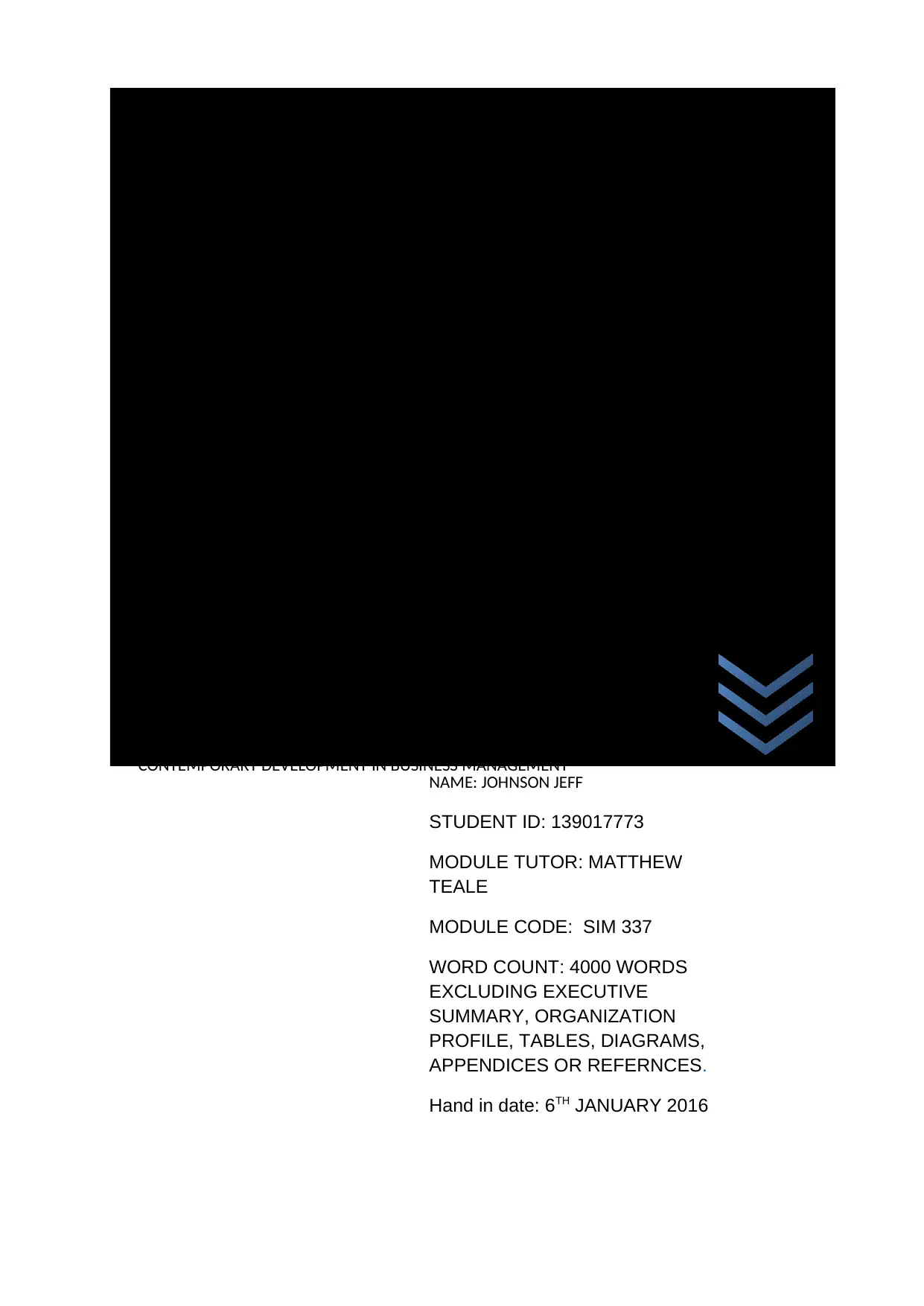
NAME: JOHNSON JEFF
STUDENT ID: 139017773
MODULE TUTOR: MATTHEW
TEALE
MODULE CODE: SIM 337
WORD COUNT: 4000 WORDS
EXCLUDING EXECUTIVE
SUMMARY, ORGANIZATION
PROFILE, TABLES, DIAGRAMS,
APPENDICES OR REFERNCES.
Hand in date: 6TH JANUARY 2016
CONTEMPORARY DEVELOPMENT IN BUSINESS MANAGEMENT
STUDENT ID: 139017773
MODULE TUTOR: MATTHEW
TEALE
MODULE CODE: SIM 337
WORD COUNT: 4000 WORDS
EXCLUDING EXECUTIVE
SUMMARY, ORGANIZATION
PROFILE, TABLES, DIAGRAMS,
APPENDICES OR REFERNCES.
Hand in date: 6TH JANUARY 2016
CONTEMPORARY DEVELOPMENT IN BUSINESS MANAGEMENT
Paraphrase This Document
Need a fresh take? Get an instant paraphrase of this document with our AI Paraphraser
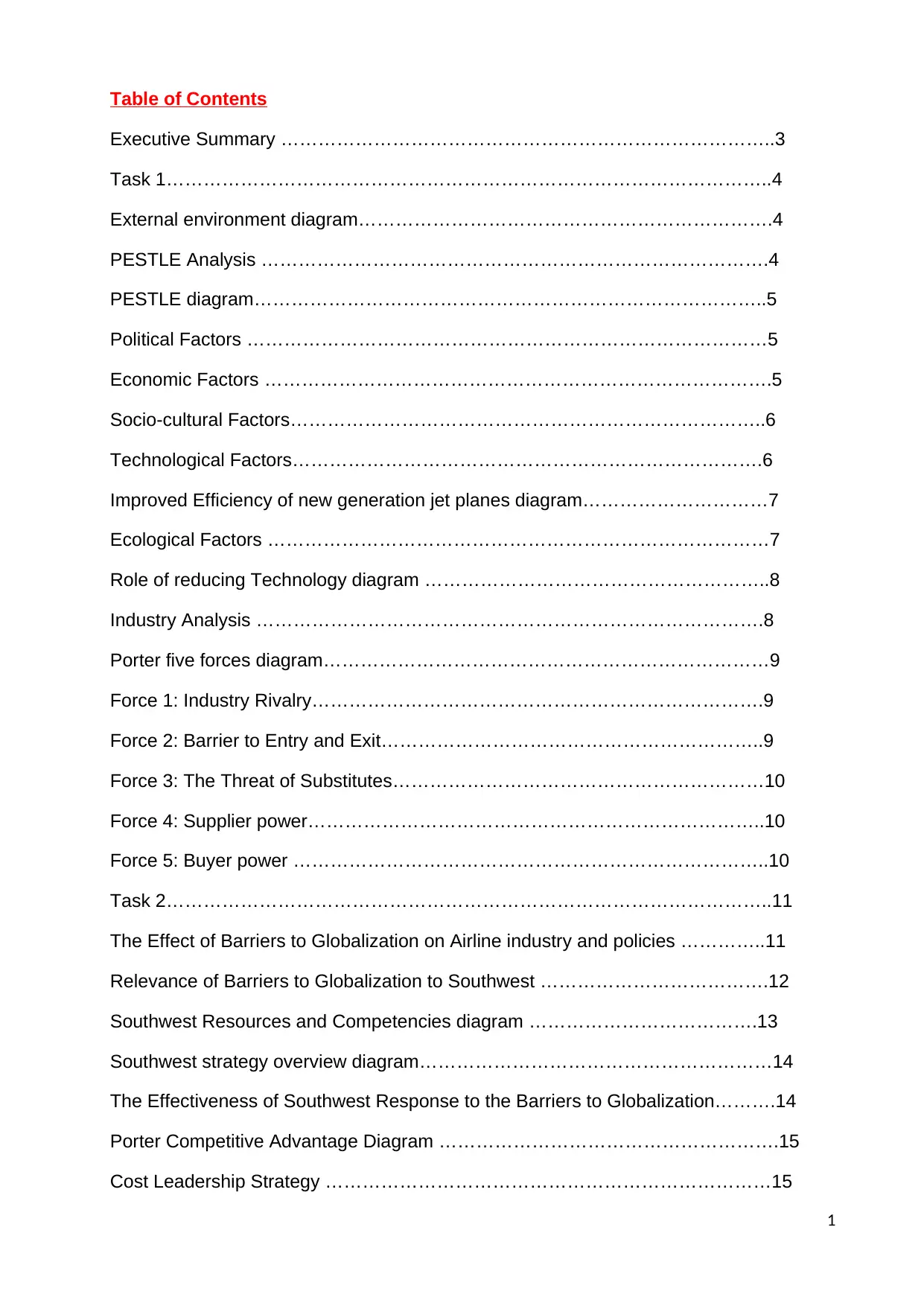
Table of Contents
Executive Summary ……………………………………………………………………..3
Task 1……………………………………………………………………………………..4
External environment diagram………………………………………………………….4
PESTLE Analysis ……………………………………………………………………….4
PESTLE diagram………………………………………………………………………..5
Political Factors …………………………………………………………………………5
Economic Factors ……………………………………………………………………….5
Socio-cultural Factors…………………………………………………………………..6
Technological Factors………………………………………………………………….6
Improved Efficiency of new generation jet planes diagram…………………………7
Ecological Factors ………………………………………………………………………7
Role of reducing Technology diagram ………………………………………………..8
Industry Analysis ……………………………………………………………………….8
Porter five forces diagram………………………………………………………………9
Force 1: Industry Rivalry……………………………………………………………….9
Force 2: Barrier to Entry and Exit……………………………………………………..9
Force 3: The Threat of Substitutes……………………………………………………10
Force 4: Supplier power………………………………………………………………..10
Force 5: Buyer power …………………………………………………………………..10
Task 2……………………………………………………………………………………..11
The Effect of Barriers to Globalization on Airline industry and policies …………..11
Relevance of Barriers to Globalization to Southwest ……………………………….12
Southwest Resources and Competencies diagram ……………………………….13
Southwest strategy overview diagram…………………………………………………14
The Effectiveness of Southwest Response to the Barriers to Globalization……….14
Porter Competitive Advantage Diagram ……………………………………………….15
Cost Leadership Strategy ………………………………………………………………15
1
Executive Summary ……………………………………………………………………..3
Task 1……………………………………………………………………………………..4
External environment diagram………………………………………………………….4
PESTLE Analysis ……………………………………………………………………….4
PESTLE diagram………………………………………………………………………..5
Political Factors …………………………………………………………………………5
Economic Factors ……………………………………………………………………….5
Socio-cultural Factors…………………………………………………………………..6
Technological Factors………………………………………………………………….6
Improved Efficiency of new generation jet planes diagram…………………………7
Ecological Factors ………………………………………………………………………7
Role of reducing Technology diagram ………………………………………………..8
Industry Analysis ……………………………………………………………………….8
Porter five forces diagram………………………………………………………………9
Force 1: Industry Rivalry……………………………………………………………….9
Force 2: Barrier to Entry and Exit……………………………………………………..9
Force 3: The Threat of Substitutes……………………………………………………10
Force 4: Supplier power………………………………………………………………..10
Force 5: Buyer power …………………………………………………………………..10
Task 2……………………………………………………………………………………..11
The Effect of Barriers to Globalization on Airline industry and policies …………..11
Relevance of Barriers to Globalization to Southwest ……………………………….12
Southwest Resources and Competencies diagram ……………………………….13
Southwest strategy overview diagram…………………………………………………14
The Effectiveness of Southwest Response to the Barriers to Globalization……….14
Porter Competitive Advantage Diagram ……………………………………………….15
Cost Leadership Strategy ………………………………………………………………15
1
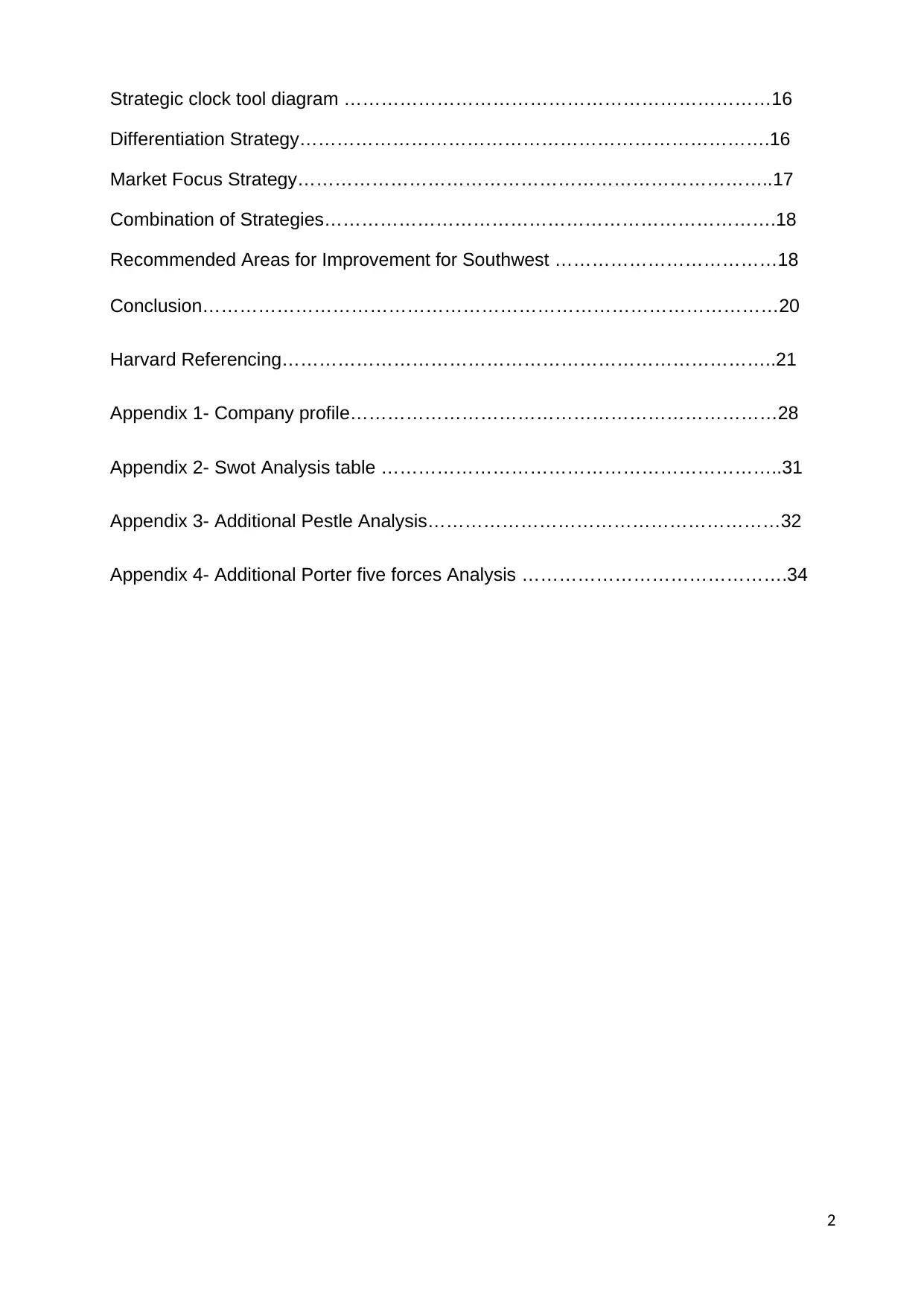
Strategic clock tool diagram ……………………………………………………………16
Differentiation Strategy………………………………………………………………….16
Market Focus Strategy…………………………………………………………………..17
Combination of Strategies……………………………………………………………….18
Recommended Areas for Improvement for Southwest ………………………………18
Conclusion…………………………………………………………………………………20
Harvard Referencing……………………………………………………………………..21
Appendix 1- Company profile……………………………………………………………28
Appendix 2- Swot Analysis table ………………………………………………………..31
Appendix 3- Additional Pestle Analysis…………………………………………………32
Appendix 4- Additional Porter five forces Analysis …………………………………….34
2
Differentiation Strategy………………………………………………………………….16
Market Focus Strategy…………………………………………………………………..17
Combination of Strategies……………………………………………………………….18
Recommended Areas for Improvement for Southwest ………………………………18
Conclusion…………………………………………………………………………………20
Harvard Referencing……………………………………………………………………..21
Appendix 1- Company profile……………………………………………………………28
Appendix 2- Swot Analysis table ………………………………………………………..31
Appendix 3- Additional Pestle Analysis…………………………………………………32
Appendix 4- Additional Porter five forces Analysis …………………………………….34
2
⊘ This is a preview!⊘
Do you want full access?
Subscribe today to unlock all pages.

Trusted by 1+ million students worldwide
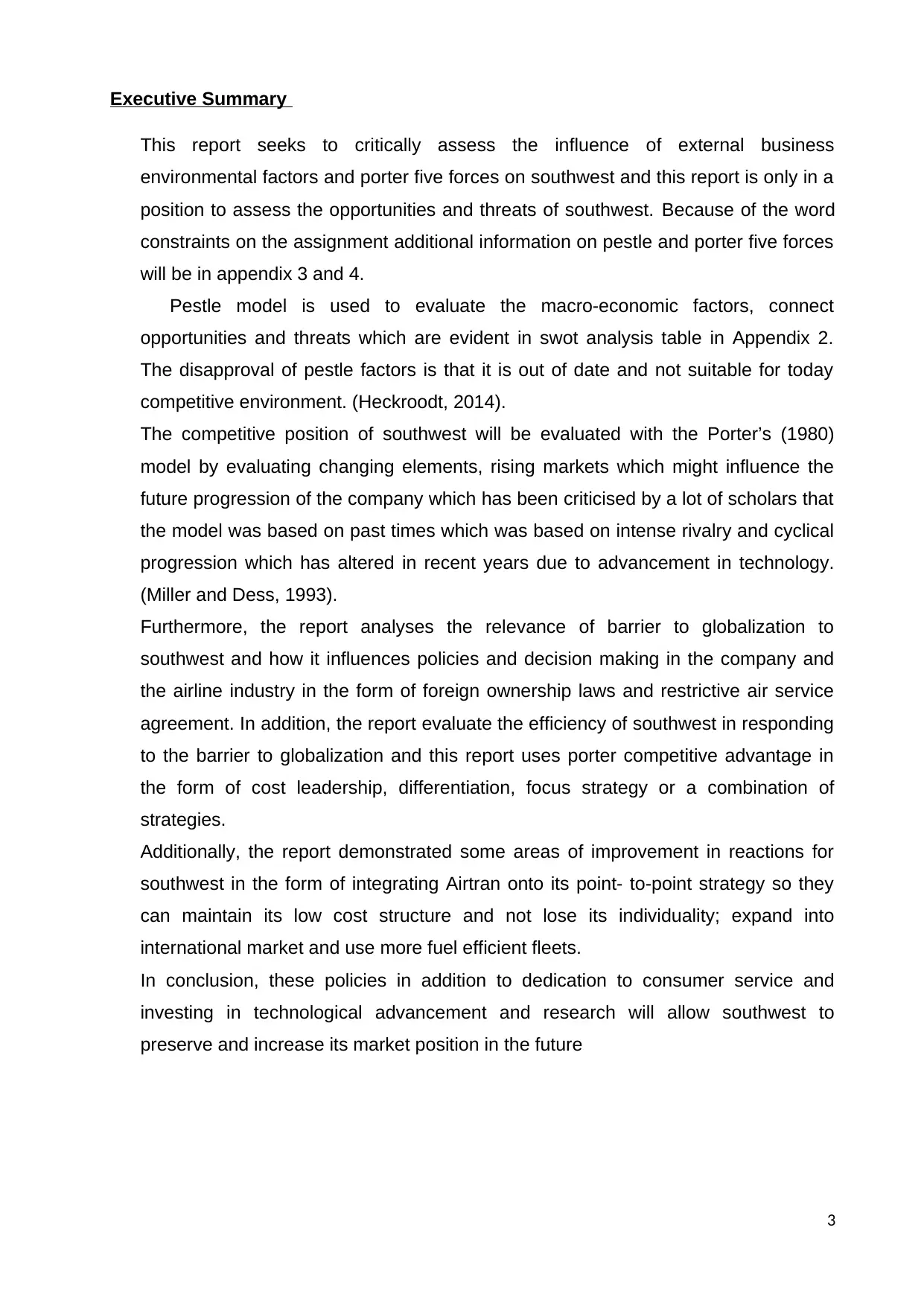
Executive Summary
This report seeks to critically assess the influence of external business
environmental factors and porter five forces on southwest and this report is only in a
position to assess the opportunities and threats of southwest. Because of the word
constraints on the assignment additional information on pestle and porter five forces
will be in appendix 3 and 4.
Pestle model is used to evaluate the macro-economic factors, connect
opportunities and threats which are evident in swot analysis table in Appendix 2.
The disapproval of pestle factors is that it is out of date and not suitable for today
competitive environment. (Heckroodt, 2014).
The competitive position of southwest will be evaluated with the Porter’s (1980)
model by evaluating changing elements, rising markets which might influence the
future progression of the company which has been criticised by a lot of scholars that
the model was based on past times which was based on intense rivalry and cyclical
progression which has altered in recent years due to advancement in technology.
(Miller and Dess, 1993).
Furthermore, the report analyses the relevance of barrier to globalization to
southwest and how it influences policies and decision making in the company and
the airline industry in the form of foreign ownership laws and restrictive air service
agreement. In addition, the report evaluate the efficiency of southwest in responding
to the barrier to globalization and this report uses porter competitive advantage in
the form of cost leadership, differentiation, focus strategy or a combination of
strategies.
Additionally, the report demonstrated some areas of improvement in reactions for
southwest in the form of integrating Airtran onto its point- to-point strategy so they
can maintain its low cost structure and not lose its individuality; expand into
international market and use more fuel efficient fleets.
In conclusion, these policies in addition to dedication to consumer service and
investing in technological advancement and research will allow southwest to
preserve and increase its market position in the future
3
This report seeks to critically assess the influence of external business
environmental factors and porter five forces on southwest and this report is only in a
position to assess the opportunities and threats of southwest. Because of the word
constraints on the assignment additional information on pestle and porter five forces
will be in appendix 3 and 4.
Pestle model is used to evaluate the macro-economic factors, connect
opportunities and threats which are evident in swot analysis table in Appendix 2.
The disapproval of pestle factors is that it is out of date and not suitable for today
competitive environment. (Heckroodt, 2014).
The competitive position of southwest will be evaluated with the Porter’s (1980)
model by evaluating changing elements, rising markets which might influence the
future progression of the company which has been criticised by a lot of scholars that
the model was based on past times which was based on intense rivalry and cyclical
progression which has altered in recent years due to advancement in technology.
(Miller and Dess, 1993).
Furthermore, the report analyses the relevance of barrier to globalization to
southwest and how it influences policies and decision making in the company and
the airline industry in the form of foreign ownership laws and restrictive air service
agreement. In addition, the report evaluate the efficiency of southwest in responding
to the barrier to globalization and this report uses porter competitive advantage in
the form of cost leadership, differentiation, focus strategy or a combination of
strategies.
Additionally, the report demonstrated some areas of improvement in reactions for
southwest in the form of integrating Airtran onto its point- to-point strategy so they
can maintain its low cost structure and not lose its individuality; expand into
international market and use more fuel efficient fleets.
In conclusion, these policies in addition to dedication to consumer service and
investing in technological advancement and research will allow southwest to
preserve and increase its market position in the future
3
Paraphrase This Document
Need a fresh take? Get an instant paraphrase of this document with our AI Paraphraser
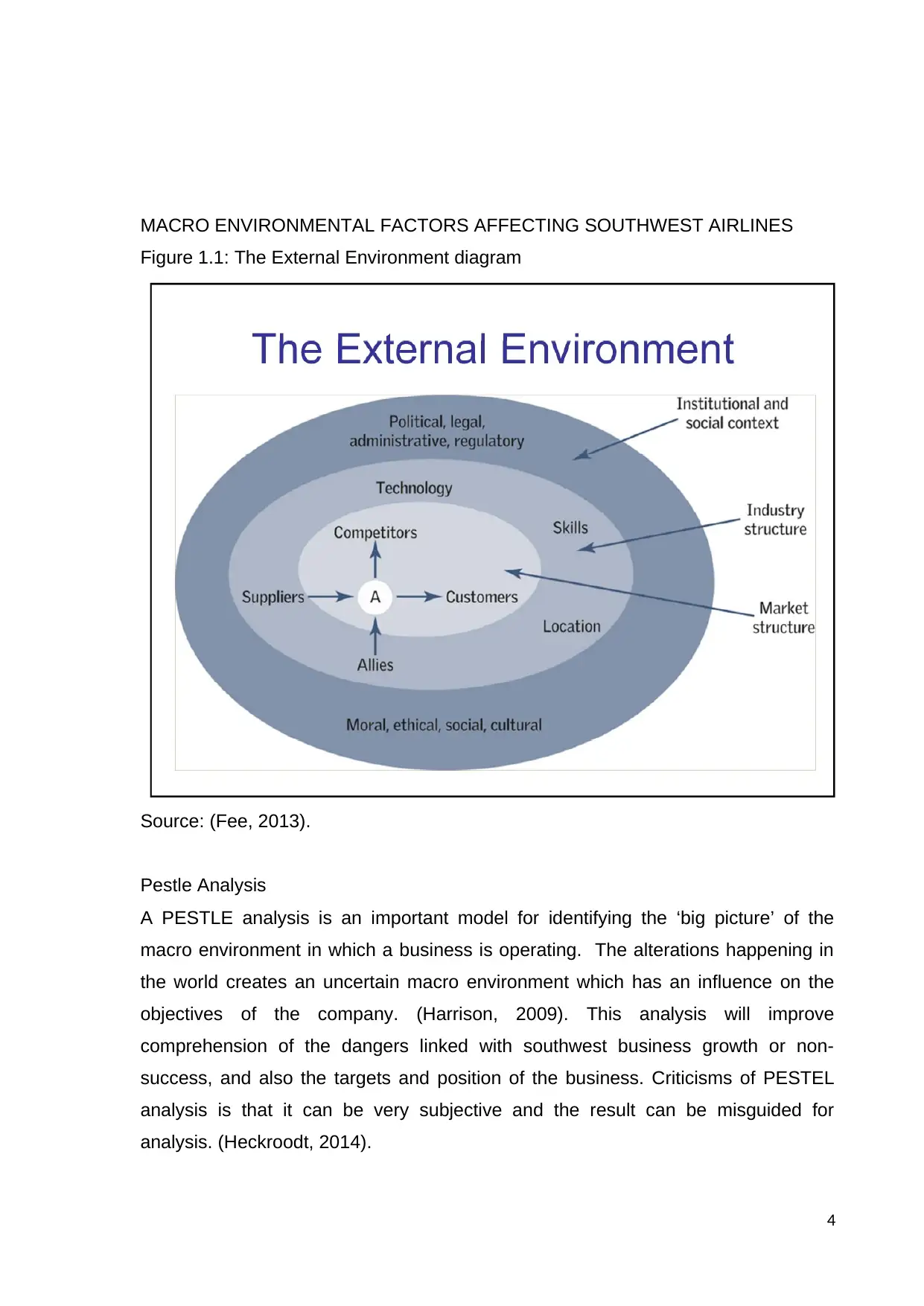
MACRO ENVIRONMENTAL FACTORS AFFECTING SOUTHWEST AIRLINES
Figure 1.1: The External Environment diagram
Source: (Fee, 2013).
Pestle Analysis
A PESTLE analysis is an important model for identifying the ‘big picture’ of the
macro environment in which a business is operating. The alterations happening in
the world creates an uncertain macro environment which has an influence on the
objectives of the company. (Harrison, 2009). This analysis will improve
comprehension of the dangers linked with southwest business growth or non-
success, and also the targets and position of the business. Criticisms of PESTEL
analysis is that it can be very subjective and the result can be misguided for
analysis. (Heckroodt, 2014).
4
Figure 1.1: The External Environment diagram
Source: (Fee, 2013).
Pestle Analysis
A PESTLE analysis is an important model for identifying the ‘big picture’ of the
macro environment in which a business is operating. The alterations happening in
the world creates an uncertain macro environment which has an influence on the
objectives of the company. (Harrison, 2009). This analysis will improve
comprehension of the dangers linked with southwest business growth or non-
success, and also the targets and position of the business. Criticisms of PESTEL
analysis is that it can be very subjective and the result can be misguided for
analysis. (Heckroodt, 2014).
4
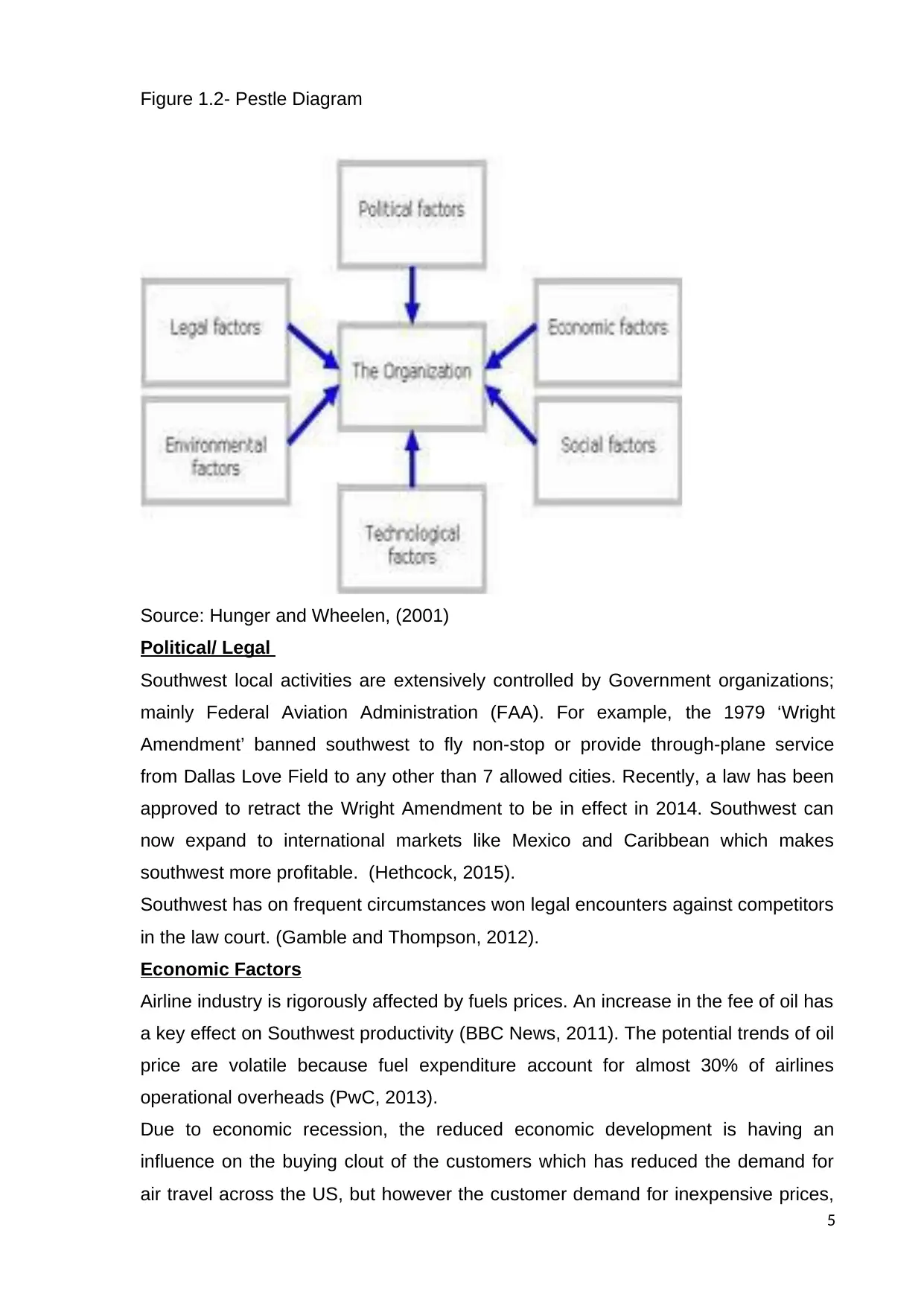
Figure 1.2- Pestle Diagram
Source: Hunger and Wheelen, (2001)
Political/ Legal
Southwest local activities are extensively controlled by Government organizations;
mainly Federal Aviation Administration (FAA). For example, the 1979 ‘Wright
Amendment’ banned southwest to fly non-stop or provide through-plane service
from Dallas Love Field to any other than 7 allowed cities. Recently, a law has been
approved to retract the Wright Amendment to be in effect in 2014. Southwest can
now expand to international markets like Mexico and Caribbean which makes
southwest more profitable. (Hethcock, 2015).
Southwest has on frequent circumstances won legal encounters against competitors
in the law court. (Gamble and Thompson, 2012).
Economic Factors
Airline industry is rigorously affected by fuels prices. An increase in the fee of oil has
a key effect on Southwest productivity (BBC News, 2011). The potential trends of oil
price are volatile because fuel expenditure account for almost 30% of airlines
operational overheads (PwC, 2013).
Due to economic recession, the reduced economic development is having an
influence on the buying clout of the customers which has reduced the demand for
air travel across the US, but however the customer demand for inexpensive prices,
5
Source: Hunger and Wheelen, (2001)
Political/ Legal
Southwest local activities are extensively controlled by Government organizations;
mainly Federal Aviation Administration (FAA). For example, the 1979 ‘Wright
Amendment’ banned southwest to fly non-stop or provide through-plane service
from Dallas Love Field to any other than 7 allowed cities. Recently, a law has been
approved to retract the Wright Amendment to be in effect in 2014. Southwest can
now expand to international markets like Mexico and Caribbean which makes
southwest more profitable. (Hethcock, 2015).
Southwest has on frequent circumstances won legal encounters against competitors
in the law court. (Gamble and Thompson, 2012).
Economic Factors
Airline industry is rigorously affected by fuels prices. An increase in the fee of oil has
a key effect on Southwest productivity (BBC News, 2011). The potential trends of oil
price are volatile because fuel expenditure account for almost 30% of airlines
operational overheads (PwC, 2013).
Due to economic recession, the reduced economic development is having an
influence on the buying clout of the customers which has reduced the demand for
air travel across the US, but however the customer demand for inexpensive prices,
5
⊘ This is a preview!⊘
Do you want full access?
Subscribe today to unlock all pages.

Trusted by 1+ million students worldwide
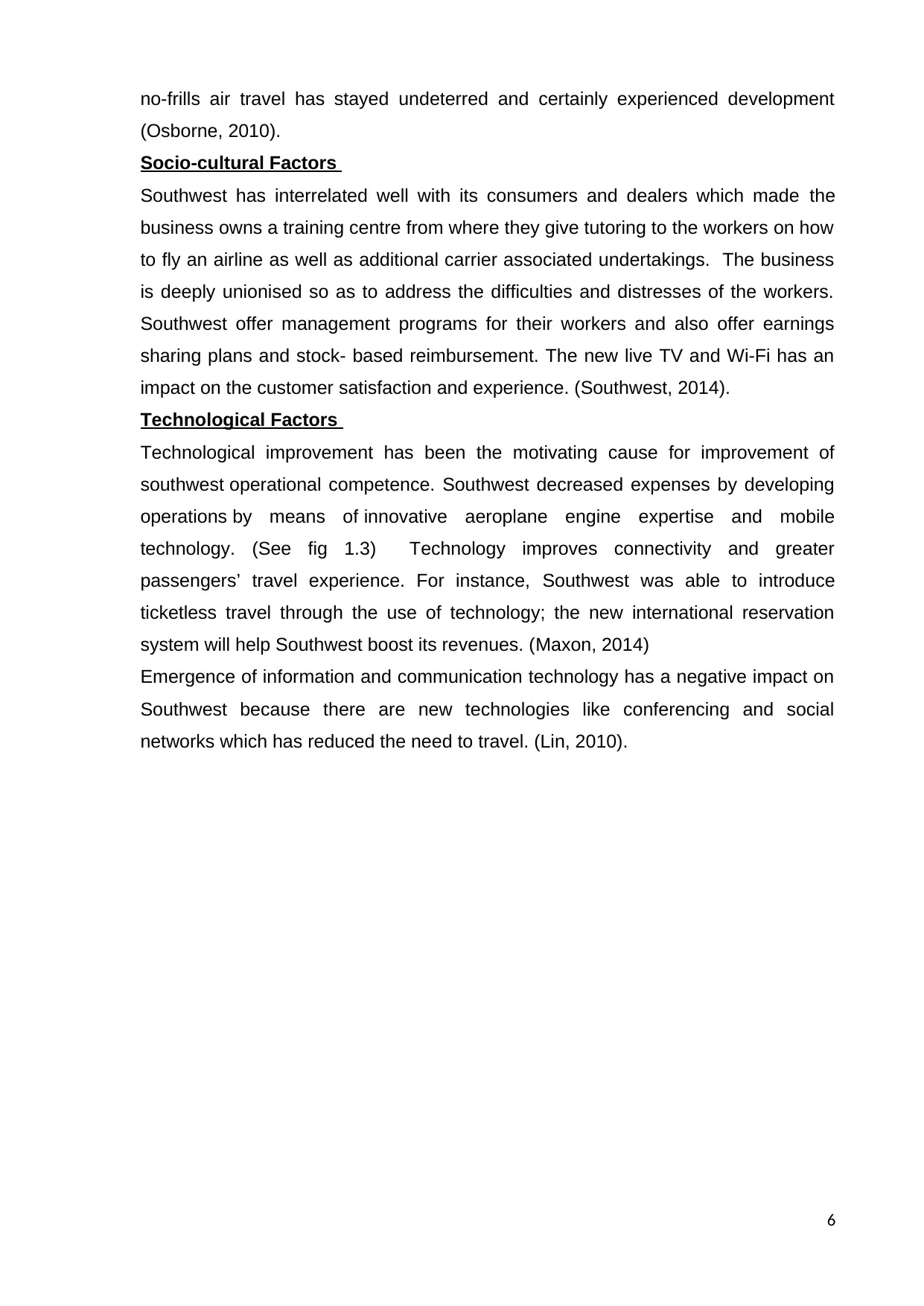
no-frills air travel has stayed undeterred and certainly experienced development
(Osborne, 2010).
Socio-cultural Factors
Southwest has interrelated well with its consumers and dealers which made the
business owns a training centre from where they give tutoring to the workers on how
to fly an airline as well as additional carrier associated undertakings. The business
is deeply unionised so as to address the difficulties and distresses of the workers.
Southwest offer management programs for their workers and also offer earnings
sharing plans and stock- based reimbursement. The new live TV and Wi-Fi has an
impact on the customer satisfaction and experience. (Southwest, 2014).
Technological Factors
Technological improvement has been the motivating cause for improvement of
southwest operational competence. Southwest decreased expenses by developing
operations by means of innovative aeroplane engine expertise and mobile
technology. (See fig 1.3) Technology improves connectivity and greater
passengers’ travel experience. For instance, Southwest was able to introduce
ticketless travel through the use of technology; the new international reservation
system will help Southwest boost its revenues. (Maxon, 2014)
Emergence of information and communication technology has a negative impact on
Southwest because there are new technologies like conferencing and social
networks which has reduced the need to travel. (Lin, 2010).
6
(Osborne, 2010).
Socio-cultural Factors
Southwest has interrelated well with its consumers and dealers which made the
business owns a training centre from where they give tutoring to the workers on how
to fly an airline as well as additional carrier associated undertakings. The business
is deeply unionised so as to address the difficulties and distresses of the workers.
Southwest offer management programs for their workers and also offer earnings
sharing plans and stock- based reimbursement. The new live TV and Wi-Fi has an
impact on the customer satisfaction and experience. (Southwest, 2014).
Technological Factors
Technological improvement has been the motivating cause for improvement of
southwest operational competence. Southwest decreased expenses by developing
operations by means of innovative aeroplane engine expertise and mobile
technology. (See fig 1.3) Technology improves connectivity and greater
passengers’ travel experience. For instance, Southwest was able to introduce
ticketless travel through the use of technology; the new international reservation
system will help Southwest boost its revenues. (Maxon, 2014)
Emergence of information and communication technology has a negative impact on
Southwest because there are new technologies like conferencing and social
networks which has reduced the need to travel. (Lin, 2010).
6
Paraphrase This Document
Need a fresh take? Get an instant paraphrase of this document with our AI Paraphraser
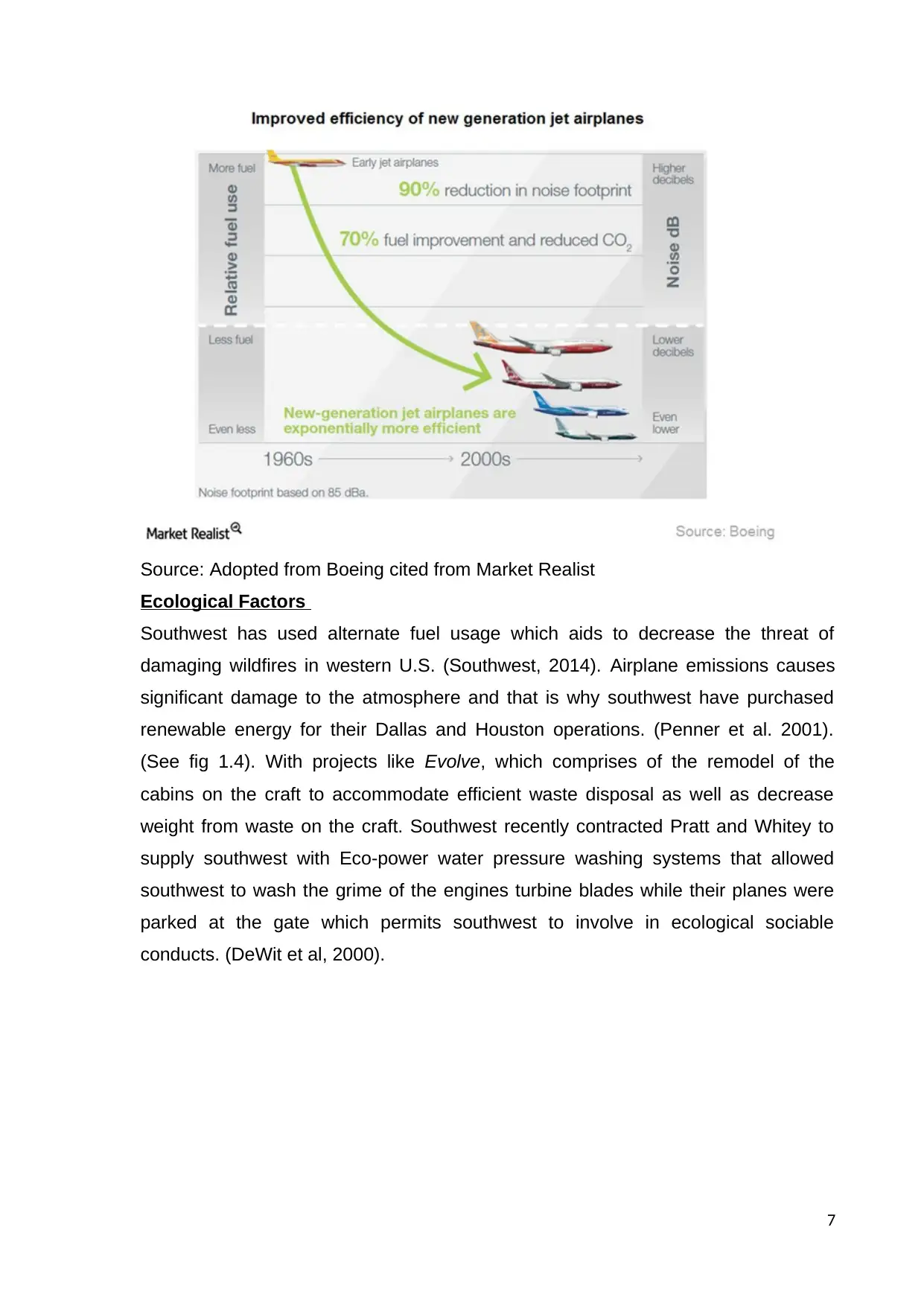
Source: Adopted from Boeing cited from Market Realist
Ecological Factors
Southwest has used alternate fuel usage which aids to decrease the threat of
damaging wildfires in western U.S. (Southwest, 2014). Airplane emissions causes
significant damage to the atmosphere and that is why southwest have purchased
renewable energy for their Dallas and Houston operations. (Penner et al. 2001).
(See fig 1.4). With projects like Evolve, which comprises of the remodel of the
cabins on the craft to accommodate efficient waste disposal as well as decrease
weight from waste on the craft. Southwest recently contracted Pratt and Whitey to
supply southwest with Eco-power water pressure washing systems that allowed
southwest to wash the grime of the engines turbine blades while their planes were
parked at the gate which permits southwest to involve in ecological sociable
conducts. (DeWit et al, 2000).
7
Ecological Factors
Southwest has used alternate fuel usage which aids to decrease the threat of
damaging wildfires in western U.S. (Southwest, 2014). Airplane emissions causes
significant damage to the atmosphere and that is why southwest have purchased
renewable energy for their Dallas and Houston operations. (Penner et al. 2001).
(See fig 1.4). With projects like Evolve, which comprises of the remodel of the
cabins on the craft to accommodate efficient waste disposal as well as decrease
weight from waste on the craft. Southwest recently contracted Pratt and Whitey to
supply southwest with Eco-power water pressure washing systems that allowed
southwest to wash the grime of the engines turbine blades while their planes were
parked at the gate which permits southwest to involve in ecological sociable
conducts. (DeWit et al, 2000).
7
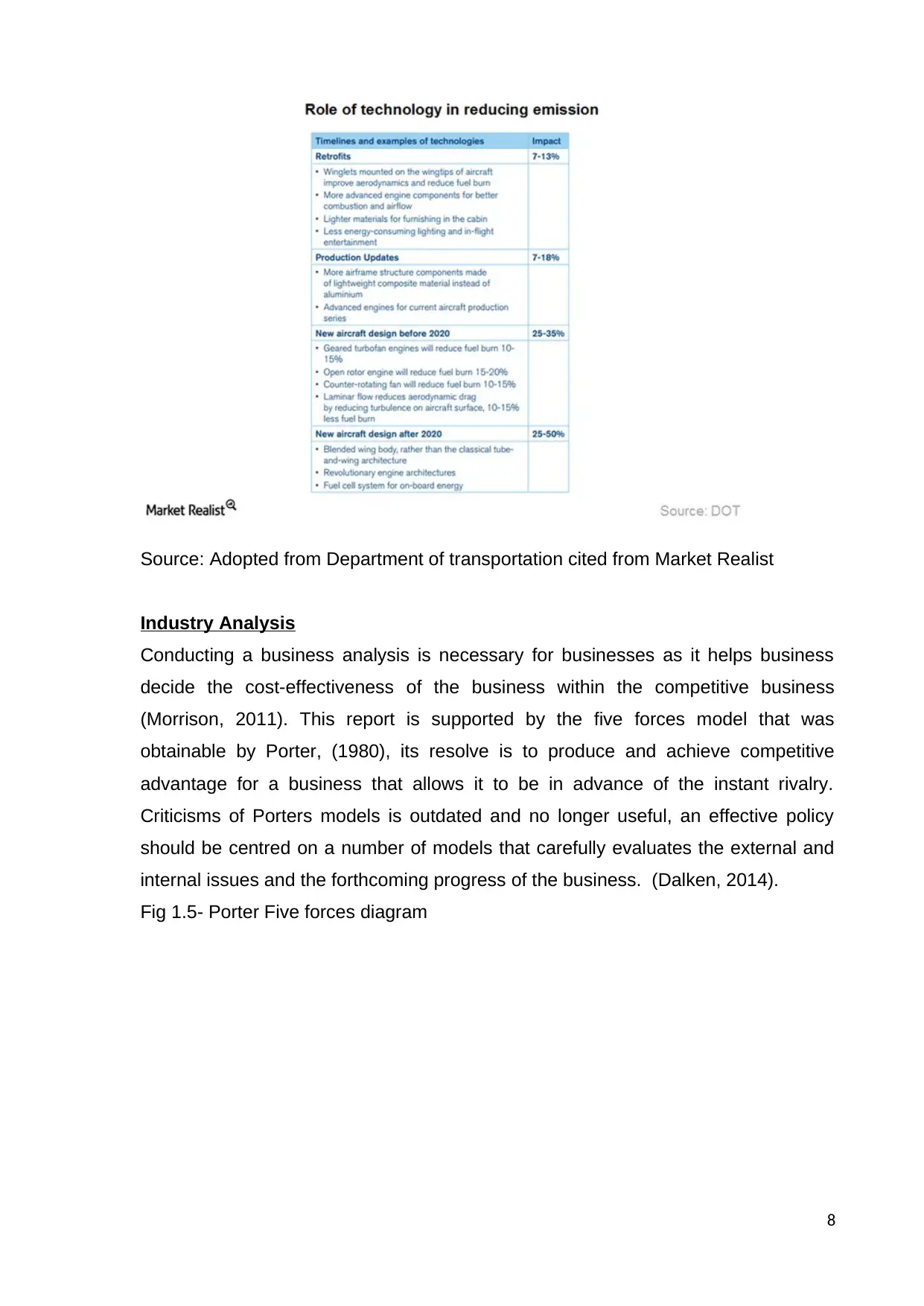
Source: Adopted from Department of transportation cited from Market Realist
Industry Analysis
Conducting a business analysis is necessary for businesses as it helps business
decide the cost-effectiveness of the business within the competitive business
(Morrison, 2011). This report is supported by the five forces model that was
obtainable by Porter, (1980), its resolve is to produce and achieve competitive
advantage for a business that allows it to be in advance of the instant rivalry.
Criticisms of Porters models is outdated and no longer useful, an effective policy
should be centred on a number of models that carefully evaluates the external and
internal issues and the forthcoming progress of the business. (Dalken, 2014).
Fig 1.5- Porter Five forces diagram
8
Industry Analysis
Conducting a business analysis is necessary for businesses as it helps business
decide the cost-effectiveness of the business within the competitive business
(Morrison, 2011). This report is supported by the five forces model that was
obtainable by Porter, (1980), its resolve is to produce and achieve competitive
advantage for a business that allows it to be in advance of the instant rivalry.
Criticisms of Porters models is outdated and no longer useful, an effective policy
should be centred on a number of models that carefully evaluates the external and
internal issues and the forthcoming progress of the business. (Dalken, 2014).
Fig 1.5- Porter Five forces diagram
8
⊘ This is a preview!⊘
Do you want full access?
Subscribe today to unlock all pages.

Trusted by 1+ million students worldwide
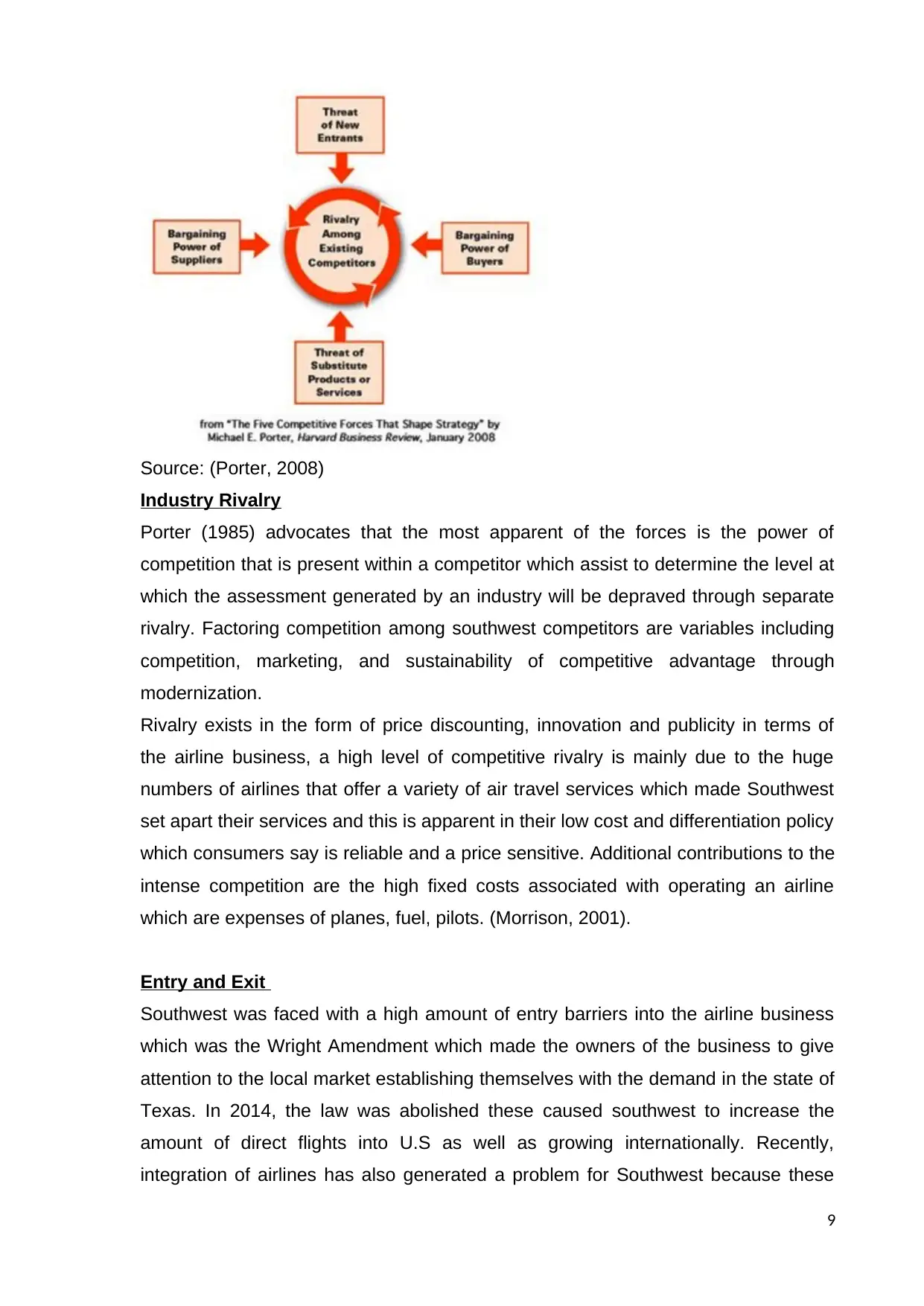
Source: (Porter, 2008)
Industry Rivalry
Porter (1985) advocates that the most apparent of the forces is the power of
competition that is present within a competitor which assist to determine the level at
which the assessment generated by an industry will be depraved through separate
rivalry. Factoring competition among southwest competitors are variables including
competition, marketing, and sustainability of competitive advantage through
modernization.
Rivalry exists in the form of price discounting, innovation and publicity in terms of
the airline business, a high level of competitive rivalry is mainly due to the huge
numbers of airlines that offer a variety of air travel services which made Southwest
set apart their services and this is apparent in their low cost and differentiation policy
which consumers say is reliable and a price sensitive. Additional contributions to the
intense competition are the high fixed costs associated with operating an airline
which are expenses of planes, fuel, pilots. (Morrison, 2001).
Entry and Exit
Southwest was faced with a high amount of entry barriers into the airline business
which was the Wright Amendment which made the owners of the business to give
attention to the local market establishing themselves with the demand in the state of
Texas. In 2014, the law was abolished these caused southwest to increase the
amount of direct flights into U.S as well as growing internationally. Recently,
integration of airlines has also generated a problem for Southwest because these
9
Industry Rivalry
Porter (1985) advocates that the most apparent of the forces is the power of
competition that is present within a competitor which assist to determine the level at
which the assessment generated by an industry will be depraved through separate
rivalry. Factoring competition among southwest competitors are variables including
competition, marketing, and sustainability of competitive advantage through
modernization.
Rivalry exists in the form of price discounting, innovation and publicity in terms of
the airline business, a high level of competitive rivalry is mainly due to the huge
numbers of airlines that offer a variety of air travel services which made Southwest
set apart their services and this is apparent in their low cost and differentiation policy
which consumers say is reliable and a price sensitive. Additional contributions to the
intense competition are the high fixed costs associated with operating an airline
which are expenses of planes, fuel, pilots. (Morrison, 2001).
Entry and Exit
Southwest was faced with a high amount of entry barriers into the airline business
which was the Wright Amendment which made the owners of the business to give
attention to the local market establishing themselves with the demand in the state of
Texas. In 2014, the law was abolished these caused southwest to increase the
amount of direct flights into U.S as well as growing internationally. Recently,
integration of airlines has also generated a problem for Southwest because these
9
Paraphrase This Document
Need a fresh take? Get an instant paraphrase of this document with our AI Paraphraser
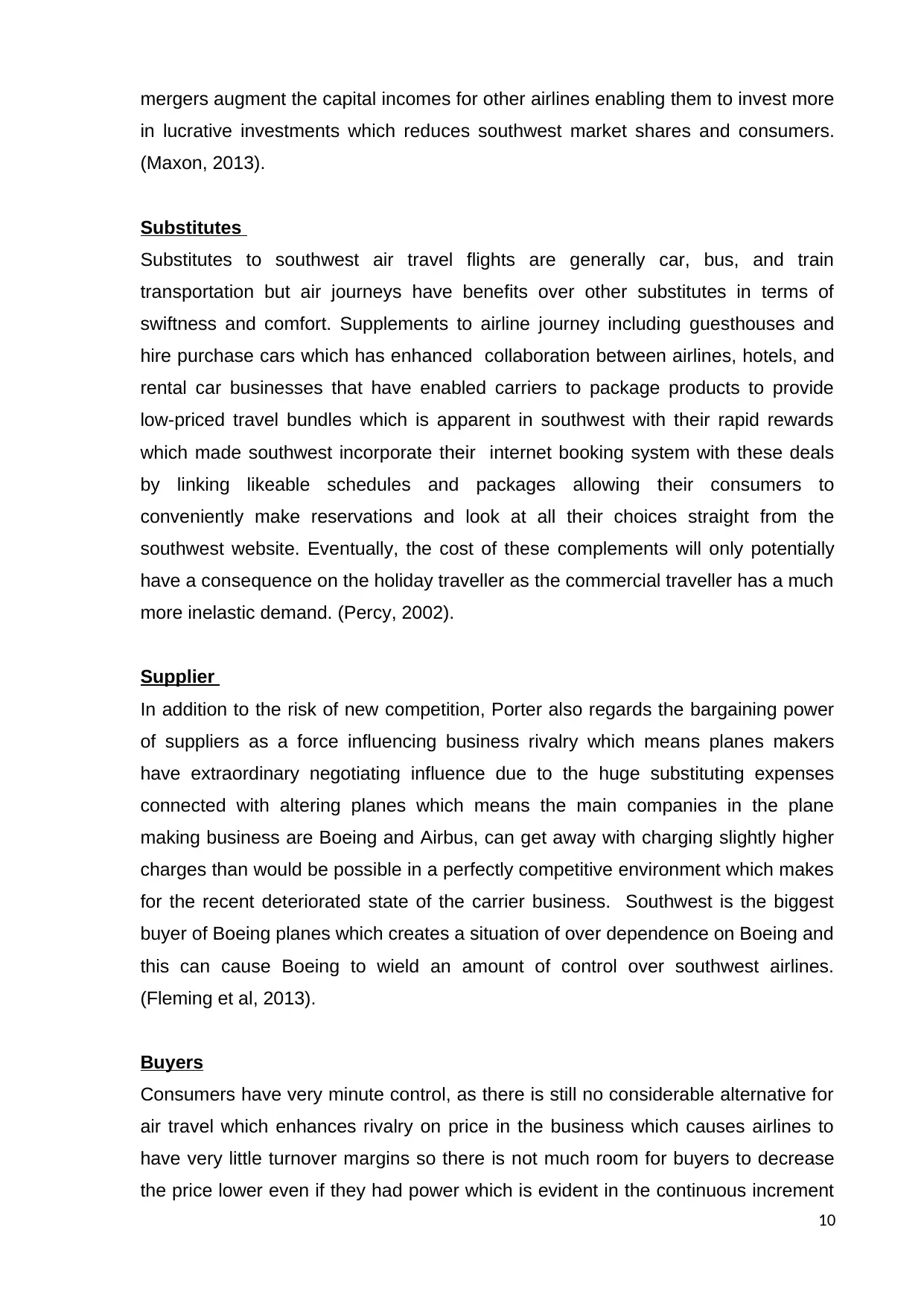
mergers augment the capital incomes for other airlines enabling them to invest more
in lucrative investments which reduces southwest market shares and consumers.
(Maxon, 2013).
Substitutes
Substitutes to southwest air travel flights are generally car, bus, and train
transportation but air journeys have benefits over other substitutes in terms of
swiftness and comfort. Supplements to airline journey including guesthouses and
hire purchase cars which has enhanced collaboration between airlines, hotels, and
rental car businesses that have enabled carriers to package products to provide
low-priced travel bundles which is apparent in southwest with their rapid rewards
which made southwest incorporate their internet booking system with these deals
by linking likeable schedules and packages allowing their consumers to
conveniently make reservations and look at all their choices straight from the
southwest website. Eventually, the cost of these complements will only potentially
have a consequence on the holiday traveller as the commercial traveller has a much
more inelastic demand. (Percy, 2002).
Supplier
In addition to the risk of new competition, Porter also regards the bargaining power
of suppliers as a force influencing business rivalry which means planes makers
have extraordinary negotiating influence due to the huge substituting expenses
connected with altering planes which means the main companies in the plane
making business are Boeing and Airbus, can get away with charging slightly higher
charges than would be possible in a perfectly competitive environment which makes
for the recent deteriorated state of the carrier business. Southwest is the biggest
buyer of Boeing planes which creates a situation of over dependence on Boeing and
this can cause Boeing to wield an amount of control over southwest airlines.
(Fleming et al, 2013).
Buyers
Consumers have very minute control, as there is still no considerable alternative for
air travel which enhances rivalry on price in the business which causes airlines to
have very little turnover margins so there is not much room for buyers to decrease
the price lower even if they had power which is evident in the continuous increment
10
in lucrative investments which reduces southwest market shares and consumers.
(Maxon, 2013).
Substitutes
Substitutes to southwest air travel flights are generally car, bus, and train
transportation but air journeys have benefits over other substitutes in terms of
swiftness and comfort. Supplements to airline journey including guesthouses and
hire purchase cars which has enhanced collaboration between airlines, hotels, and
rental car businesses that have enabled carriers to package products to provide
low-priced travel bundles which is apparent in southwest with their rapid rewards
which made southwest incorporate their internet booking system with these deals
by linking likeable schedules and packages allowing their consumers to
conveniently make reservations and look at all their choices straight from the
southwest website. Eventually, the cost of these complements will only potentially
have a consequence on the holiday traveller as the commercial traveller has a much
more inelastic demand. (Percy, 2002).
Supplier
In addition to the risk of new competition, Porter also regards the bargaining power
of suppliers as a force influencing business rivalry which means planes makers
have extraordinary negotiating influence due to the huge substituting expenses
connected with altering planes which means the main companies in the plane
making business are Boeing and Airbus, can get away with charging slightly higher
charges than would be possible in a perfectly competitive environment which makes
for the recent deteriorated state of the carrier business. Southwest is the biggest
buyer of Boeing planes which creates a situation of over dependence on Boeing and
this can cause Boeing to wield an amount of control over southwest airlines.
(Fleming et al, 2013).
Buyers
Consumers have very minute control, as there is still no considerable alternative for
air travel which enhances rivalry on price in the business which causes airlines to
have very little turnover margins so there is not much room for buyers to decrease
the price lower even if they had power which is evident in the continuous increment
10
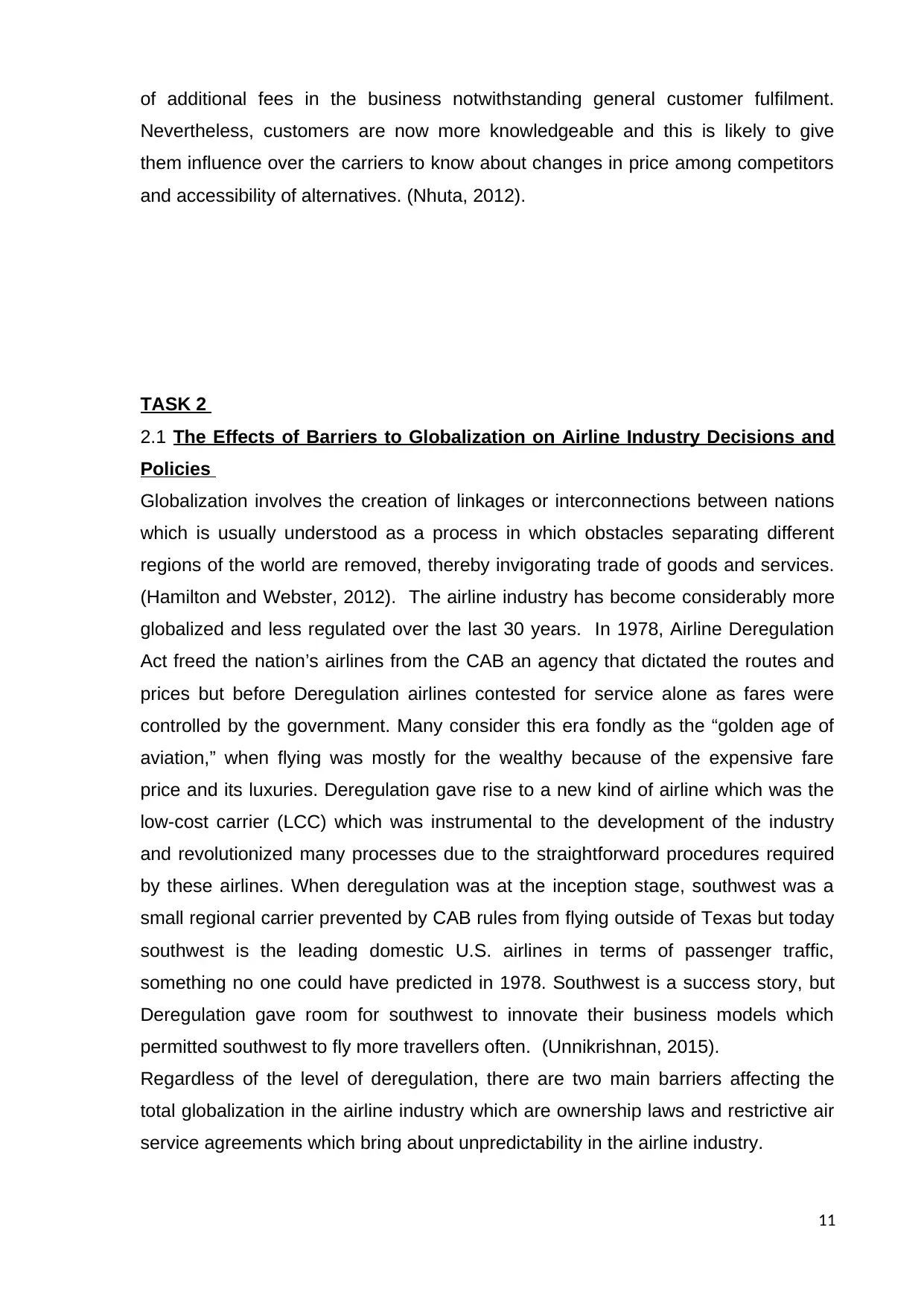
of additional fees in the business notwithstanding general customer fulfilment.
Nevertheless, customers are now more knowledgeable and this is likely to give
them influence over the carriers to know about changes in price among competitors
and accessibility of alternatives. (Nhuta, 2012).
TASK 2
2.1 The Effects of Barriers to Globalization on Airline Industry Decisions and
Policies
Globalization involves the creation of linkages or interconnections between nations
which is usually understood as a process in which obstacles separating different
regions of the world are removed, thereby invigorating trade of goods and services.
(Hamilton and Webster, 2012). The airline industry has become considerably more
globalized and less regulated over the last 30 years. In 1978, Airline Deregulation
Act freed the nation’s airlines from the CAB an agency that dictated the routes and
prices but before Deregulation airlines contested for service alone as fares were
controlled by the government. Many consider this era fondly as the “golden age of
aviation,” when flying was mostly for the wealthy because of the expensive fare
price and its luxuries. Deregulation gave rise to a new kind of airline which was the
low-cost carrier (LCC) which was instrumental to the development of the industry
and revolutionized many processes due to the straightforward procedures required
by these airlines. When deregulation was at the inception stage, southwest was a
small regional carrier prevented by CAB rules from flying outside of Texas but today
southwest is the leading domestic U.S. airlines in terms of passenger traffic,
something no one could have predicted in 1978. Southwest is a success story, but
Deregulation gave room for southwest to innovate their business models which
permitted southwest to fly more travellers often. (Unnikrishnan, 2015).
Regardless of the level of deregulation, there are two main barriers affecting the
total globalization in the airline industry which are ownership laws and restrictive air
service agreements which bring about unpredictability in the airline industry.
11
Nevertheless, customers are now more knowledgeable and this is likely to give
them influence over the carriers to know about changes in price among competitors
and accessibility of alternatives. (Nhuta, 2012).
TASK 2
2.1 The Effects of Barriers to Globalization on Airline Industry Decisions and
Policies
Globalization involves the creation of linkages or interconnections between nations
which is usually understood as a process in which obstacles separating different
regions of the world are removed, thereby invigorating trade of goods and services.
(Hamilton and Webster, 2012). The airline industry has become considerably more
globalized and less regulated over the last 30 years. In 1978, Airline Deregulation
Act freed the nation’s airlines from the CAB an agency that dictated the routes and
prices but before Deregulation airlines contested for service alone as fares were
controlled by the government. Many consider this era fondly as the “golden age of
aviation,” when flying was mostly for the wealthy because of the expensive fare
price and its luxuries. Deregulation gave rise to a new kind of airline which was the
low-cost carrier (LCC) which was instrumental to the development of the industry
and revolutionized many processes due to the straightforward procedures required
by these airlines. When deregulation was at the inception stage, southwest was a
small regional carrier prevented by CAB rules from flying outside of Texas but today
southwest is the leading domestic U.S. airlines in terms of passenger traffic,
something no one could have predicted in 1978. Southwest is a success story, but
Deregulation gave room for southwest to innovate their business models which
permitted southwest to fly more travellers often. (Unnikrishnan, 2015).
Regardless of the level of deregulation, there are two main barriers affecting the
total globalization in the airline industry which are ownership laws and restrictive air
service agreements which bring about unpredictability in the airline industry.
11
⊘ This is a preview!⊘
Do you want full access?
Subscribe today to unlock all pages.

Trusted by 1+ million students worldwide
1 out of 41
Your All-in-One AI-Powered Toolkit for Academic Success.
+13062052269
info@desklib.com
Available 24*7 on WhatsApp / Email
![[object Object]](/_next/static/media/star-bottom.7253800d.svg)
Unlock your academic potential
Copyright © 2020–2025 A2Z Services. All Rights Reserved. Developed and managed by ZUCOL.